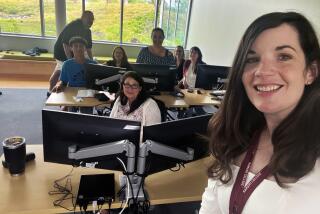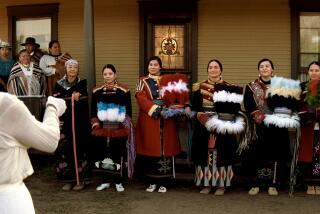Scientist-Detective Feels for Murder Clues in Bones, Old or New : Forensics: Douglas W. Owsley is a skeletal biologist with training in archeology. He helps police find and decipher fresher remains.
WASHINGTON — It was a perfect place to bury a body.
The grounds of the high-rise apartment building were overgrown with brush. Anyone on an unsavory midnight errand easily would have gone unnoticed.
Moreover, this was where an informant had told police they could find the body of a young woman who had disappeared eight months earlier.
But to the experienced eye of the Smithsonian Institution’s Douglas W. Owsley, it was evident the body wasn’t there.
“We do a lot of work with soils and looking for disturbed features,” said Owsley, one of only about 60 trained forensic anthropologists in the United States. “You’ll see a depression or maybe cracking in the soil, or you’ll see lower subsoils that have been disturbed, brought out, mixed with topsoil.”
The resulting discoloration, said the 42-year-old scientist, is a dead giveaway.
Like most others in his unusual field, Owsley is a skeletal biologist with training in archeology. His experience recovering and studying ancient bones enables him to help law enforcement agencies find and identify fresher remains.
Owsley lives two very different lives. In one he is a serious scholar, specializing in the remains of prehistoric Great Plains Indians. He publishes research papers on such esoteric subjects as the duration of breast-feeding among American Indian hunter-gatherers and maize-growers.
In his other life, he’s a gumshoe.
“In any given jurisdiction, law enforcement agencies are inevitably going to face badly decomposed remains or a skeleton, but only irregularly,” said Owsley. “A detective may see one case in three years. So they are not totally prepared to systematically excavate the remains.”
Several years ago Owsley found and identified what was left of Milwaukee mass murderer Jeffrey Dahmer’s first victim. It was one of Owsley’s more challenging assignments because the victim had been dismembered and the bones crushed and spread over two acres.
Another challenge was identifying the cremated remains of two American journalists killed by a local civil patrol in Guatemala. All that was left were three small, charred bone fragments.
“Bones are like books,” Owsley said. “Most people are not aware of the wealth of information you can reconstruct from them. They tell you a lot about that person and what happened to the individual. You find out how old the person is, what sex and race, how tall, how robust, their activity patterns in life.”
This spring Owsley will testify in the case of the young Washington woman. Police were certain she had been murdered, but without a body, their prime suspect could not be prosecuted.
Acting on a tip, the police asked Owsley to examine the rear of the building where the woman had gone apartment-hunting before she disappeared.
After Owsley ruled out the area as a possible burial site, more information from the informant--and a re-enactment of what police believed happened--led to the building’s furnace room.
“There was a large retaining wall,” Owsley recalled. “I crawled up there and got back into a sand-packed area. I noticed a depression and a subtle mound in the sand. That’s where she was.”
On a more typical day, Owsley works behind a gray steel desk in a cramped, cluttered space in the Smithsonian’s Museum of Natural History. His office is lined with plaques from various police agencies, including the FBI, commending him for helping solve crimes.
In the hall are hundreds of boxes containing ancient bones from sites throughout the United States.
Not all the bones are those of American Indians. One skull, its front caved in by a war club, belonged to a member of Gen. George A. Custer’s unlucky party at the Battle of Little Bighorn.
In his office, Owsley held up a newer skull, another artifact from a criminal case in Washington, with numerous holes in it, each about the size of a half-dollar. “The weapon here was a hammer,” he said.
Another case Owsley helped solve involved a woman who had been killed with a shotgun and dumped in the Mississippi River. Police found a bone fragment in the suspect’s pickup truck. The suspect claimed it was from a deer. Owsley proved otherwise, and today the man and an accomplice are serving time.
A strong stomach is required in Owsley’s line of work. He employs what he calls “selective numbing” to cope with the physical and sometimes emotional effects of dealing with murderers and the murdered.
“The thing that helps is the fact that you do help the families,” he said. “You’re often able to provide information, and they’re often desperate to know what happened to their loved one. By helping in identifying that person and shedding light on what happened, you may prevent it from happening to someone else.”
Owsley had intended to become a physician. A University of Wyoming archeological field trip to Mexico, in which he helped recover remains of pre-Columbian Aztecs, altered his plans.
He became an enthusiastic student of skeletons. Occasionally, when he was dating his future wife, he boiled the head of a road-killed bobcat on her apartment stove, an accepted method of stripping a skull for study. Shortly after the wedding, he said, “she cut that out.”
In addition to prehistoric Plains Indians, Owsley’s work has taken him into the 17th Century, the dark ages of colonial America. Few written records survive from that harrowing period when English settlers in such places as Jamestown, Va., and St. Marys City, Md., struggled for a foothold on a new, often hostile, continent.
But the bones tell Owsley much of their story.
More to Read
Sign up for Essential California
The most important California stories and recommendations in your inbox every morning.
You may occasionally receive promotional content from the Los Angeles Times.










